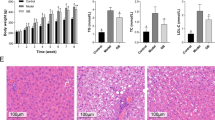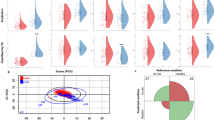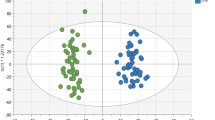Abstract
Aim:
To evaluate the lipid-regulating effects of extract from Ginkgo biloba leaves (EGB) using pharmacological methods and metabonomic profiling in a rat model of diet-induced hyperlipidemia.
Methods:
EGB was orally administered at a dose level of 40 mg/kg in both the EGB-prevention and -treatment groups. All rat samples obtained were examined for known and potential biomarkers and enzyme activity using commercial assay kits and GC/MS-based metabonomic profiling coupled with principal component analysis (PCA).
Results:
The data obtained from the assay kits indicated that EGB reduced total cholesterol and low density lipoprotein cholesterol levels and increased high density lipoprotein cholesterol levels in rat plasma obtained from both the EGB-prevention and –treatment groups compared with those of the diet-induced hyperlipidemia group. EGB also increased the activities of lipoprotein lipase and hepatic lipase and excretion of fecal bile acid in rats from the EGB-prevention and–treatment groups. Using GC/MS-based metabonomic analysis, more than 40 endogenous metabolites were identified in rat plasma. PCA of rat plasma samples obtained using GC/MS produced a distinctive separation of the four treatment groups and sampling points within each group. Metabolic changes during hyperlipidemia formation and improvement resulting from EGB treatment were definitively monitored with PCA score plots. Furthermore, elevated levels of sorbitol, tyrosine, glutamine and glucose, and decreased levels of citric acid, galactose, palmitic acid, arachidonic acid, acetic acid, cholesterol, butyrate, creatinine, linoleate, ornithine and proline, were observed in the plasma of rats treated with EGB.
Conclusion:
EGB exerts multi-directional lipid-lowering effects on the rat metabonome, including limitation of the absorption of cholesterol, inactivation of HMGCoA and favorable regulation of profiles of essential polyunsaturated fatty acid (EFA). Further experiments are warranted to explore the mechanisms of action underlying the lipid-regulating effects of EGB against hyperlipidemia.
Similar content being viewed by others
Log in or create a free account to read this content
Gain free access to this article, as well as selected content from this journal and more on nature.com
or
References
Myler RK, Ryan C, Dunlap R, Shaw RE, Bashour TT, Cumberland DC, et al. Dyslipoproteinemias in atherosclerosis, thrombosis and restenosis after coronary angioplasty. J Invasive Cardiol 1995; 7: 33–46.
Malloy MJ, Kane JP . Agents used in hyperlipidemia. In: Katzung BG, Ed. Basic & Clinical Pharmacology. New York: McGraw-Hill Companies, Inc; 2001. p 581–595.
Zhou W, Chai H, Lin PH, Lumsden AB, Yao Q, Chen C . Clinical use and molecular mechanisms of action of extract of Ginkgo biloba leaves in cardiovascular diseases. Cardiovasc Drug Rev 2004; 22: 309–19.
Bursill CA, Roach PD . A green tea catechin extract upregulates the hepatic low-density lipoprotein receptor in rats. Lipids 2007; 42: 621–7.
Bursill CA, Abbey M, Roach PD . A green tea extract lowers plasma cholesterol by inhibiting cholesterol synthesis and upregulating the LDL receptor in the cholesterol-fed rabbit. Atherosclerosis 2007; 193: 86–93.
Ho JW, Jie M . Pharmacological activity of cardiovascular agents from herbal medicine. Cardiovasc Hematol Agents Med Chem 2007; 5: 273–7.
DeFeudis FV, Drieu K . Ginkgo biloba extract (EGb 761) and CNS functions: basic studies and clinical applications. Curr Drug Targets 2000; 1: 25–58.
McKenna DJ, Jones K, Hughes K . Efficacy, safety, and use of Ginkgo biloba in clinical and preclinical applications. Altern Ther Health Med 2001; 7: 70–86, 88–90.
Yao ZX, Han Z, Drieu K, Papadopoulos V . Ginkgo biloba extract (Egb 761) inhibits beta-amyloid production by lowering free cholesterol levels. J Nutr Biochem 2004; 15: 749–56.
Singh B, Kaur P, Gopichand, Singh RD, Ahuja PS . Biology and chemistry of Ginkgo biloba. Fitoterapia 2008; 79: 401–18.
Kenzelmann R, Kade F . Limitation of the deterioration of lipid parameters by a standardized garlic-ginkgo combination product. A multicenter placebo-controlled double-blind study. Arzneimittelforschung 1993; 43: 978–81.
Barner JC, Worchel J, Min Y . Frequency of new-onset diabetes mellitus and use of antipsychotic drugs among central texas veterans. Pharmacotherapy 2004; 24: 1529–38.
Yao P, Song F, Li K, Zhou S, Liu S, Sun X, et al. Ginkgo biloba extract prevents ethanol induced dyslipidemia. Am J Chin Med 2007; 35: 643–52.
Nicholson JK, Lindon JC, Holmes E . 'Metabonomics': understanding the metabolic responses of living systems to pathophysiological stimuli via multivariate statistical analysis of biological NMR spectroscopic data. Xenobiotica 1999; 29: 1181–9.
Nicholson JK, Lindon JC . Systems biology: Metabonomics. Nature 2008; 455: 1054–6.
Brindle JT, Antti H, Holmes E, Tranter G, Nicholson JK, Bethell HW, et al. Rapid and noninvasive diagnosis of the presence and severity of coronary heart disease using 1H-NMR-based metabonomics. Nat Med 2002; 8: 1439–44.
Denkert C, Budczies J, Kind T, Weichert W, Tablack P, Sehouli J, et al. Mass spectrometry-based metabolic profiling reveals different metabolite patterns in invasive ovarian carcinomas and ovarian borderline tumors. Cancer Res 2006; 66: 10795–804.
Lewis GD, Asnani A, Gerszten RE . Application of metabolomics to cardiovascular biomarker and pathway discovery. J Am Coll Cardiol 2008; 52: 117–23.
Lewis GD, Wei R, Liu E, Yang E, Shi X, Martinovic M, et al. Metabolite profiling of blood from individuals undergoing planned myocardial infarction reveals early markers of myocardial injury. J Clin Invest 2008; 118: 3503–12.
Lindon JC, Holmes E, Nicholson JK . Metabonomics in pharmaceutical R&D. FEBS J 2007; 274: 1140–51.
Clayton TA, Lindon JC, Everett JR, Charuel C, Hanton G, Le Net JL . Hepatotoxin-induced hypertyrosinemia and its toxicological significance. Arch Toxicol 2007; 81: 201–10.
Clayton TA, Lindon JC, Cloarec O, Antti H, Charuel C, Hanton G, et al. Pharmaco-metabonomic phenotyping and personalized drug treatment. Nature 2006; 440: 1073–7.
Beisson F, Tiss A, Riviere C, Verger R . Methods for lipase detection and assay: a critical review. Eur J Lipid Sci Technol 2000; 102: 133–53.
Jiye A, Trygg J, Gullberg J, Johansson AI, Jonsson P, Antti H, et al. Extraction and GC/MS analysis of the human blood plasma metabolome. Anal Chem 2005; 77: 8086–94.
Wishart DS, Tzur D, Knox C, Eisner R, Guo AC, Young N, et al. HMDB: the Human Metabolome Database. Nucleic Acids Res 2007; 35: D521–526.
Bro R, Kjeldahl K, Smilde AK, Kiers HA . Cross-validation of component models: a critical look at current methods. Anal Bioanal Chem 2008; 390: 1241–51.
Zhang Q, Wang G, Du Y, Zhu L, Jiye A . GC/MS analysis of the rat urine for metabonomic research. J Chromatogr B Analyt Technol Biomed Life Sci 2007; 854: 20–5.
Bornhoft G, Maxion-Bergemann S, Matthiessen PF . External validity of clinical trials for treatment of dementia with Ginkgo biloba extracts. Z Gerontol Geriatr 2008; 41: 298–312.
Coley N, Andrieu S, Gardette V, Gillette-Guyonnet S, Sanz C, Vellas B, et al. Dementia prevention: methodological explanations for inconsistent results. Epidemiol Rev 2008; 30: 35–66.
Rosendorff C, Beeri MS, Silverman JM . Cardiovascular risk factors for Alzheimer's disease. Am J Geriatr Cardiol 2007; 16: 143–9.
West R, Beeri MS, Schmeidler J, Hannigan CM, Angelo G, Grossman HT, et al. Better memory functioning associated with higher total and low-density lipoprotein cholesterol levels in very elderly subjects without the apolipoprotein e4 allele. Am J Geriatr Psychiatry 2008; 16: 781–5.
Lippi G, Targher G, Guidi GC . Ginkgo biloba, inflammation and lipoprotein(a). Atherosclerosis 2007; 195: 417–8.
Rodriguez M, Ringstad L, Schafer P, Just S, Hofer HW, Malmsten M, et al. Reduction of atherosclerotic nanoplaque formation and size by Ginkgo biloba (EGb 761) in cardiovascular high-risk patients. Atherosclerosis 2007; 192: 438–44.
Bok SH, Park SY, Park YB, Lee MK, Jeon SM, Jeong TS, et al. Quercetin dihydrate and gallate supplements lower plasma and hepatic lipids and change activities of hepatic antioxidant enzymes in high cholesterol-fed rats. Int J Vitam Nutr Res 2002; 72: 161–9.
Santamarina-Fojo S, Gonzalez-Navarro H, Freeman L, Wagner E, Nong Z . Hepatic lipase, lipoprotein metabolism, and atherogenesis. Arterioscler Thromb Vasc Biol 2004; 24: 1750–4.
Charlton-Menys V, Durrington PN . Human cholesterol metabolism and therapeutic molecules. Exp Physiol 2008; 93: 27–42.
Buhaescu I, Izzedine H . Mevalonate pathway: a review of clinical and therapeutical implications. Clin Biochem 2007; 40: 575–84.
Norlin M, Wikvall K . Enzymes in the conversion of cholesterol into bile acids. Curr Mol Med 2007; 7: 199–218.
Charach G, Rabinovich PD, Konikoff FM, Grosskopf I, Weintraub MS, Gilat T . Decreased fecal bile acid output in patients with coronary atherosclerosis. J Med 1998; 29: 125–36.
Ringheim GE, Szczepanik AM . Brain inflammation, cholesterol, and glutamate as interconnected participants in the pathology of Alzheimer's disease. Curr Pharm Des 2006; 12: 719–38.
Nicholls DG . Oxidative stress and energy crises in neuronal dysfunction. Ann N Y Acad Sci 2008; 1147: 53–60.
Garlick PJ . Assessment of the safety of glutamine and other amino acids. J Nutr 2001; 131: 2556S–2561S.
Tapiero H, Ba GN, Couvreur P, Tew KD . Polyunsaturated fatty acids (PUFA) and eicosanoids in human health and pathologies. Biomed Pharmacother 2002; 56: 215–22.
Watford M . Glutamine metabolism and function in relation to proline synthesis and the safety of glutamine and proline supplementation. J Nutr 2008; 138: 2003S–2007S.
Brosnan JT . Glutamate, at the interface between amino acid and carbohydrate metabolism. J Nutr 2000; 130: 988S–990S.
Tapiero H, Mathe G, Couvreur P, Tew KD II . Glutamine and glutamate. Biomed Pharmacother 2002; 56: 446–57.
Federici M, Lauro R . Review article: diabetes and atherosclerosis--running on a common road. Aliment Pharmacol Ther 2005; 22(Suppl 2): 11–5.
Obrosova IG . Increased sorbitol pathway activity generates oxidative stress in tissue sites for diabetic complications. Antioxid Redox Signal 2005; 7: 1543–52.
Forbes JM, Coughlan MT, Cooper ME . Oxidative stress as a major culprit in kidney disease in diabetes. Diabetes 2008; 57: 1446–54.
Le KA, Tappy L . Metabolic effects of fructose. Curr Opin Clin Nutr Metab Care 2006; 9: 469–75.
Lotito SB, Frei B . Consumption of flavonoid-rich foods and increased plasma antioxidant capacity in humans: cause, consequence, or epiphenomenon? Free Radic Biol Med 2006; 41: 1727–46.
Ioachimescu AG, Brennan DM, Hoar BM, Hazen SL, Hoogwerf BJ . Serum uric acid is an independent predictor of all-cause mortality in patients at high risk of cardiovascular disease: a preventive cardiology information system (PreCIS) database cohort study. Arthritis Rheum 2008; 58: 623–30.
Play B, Salvini S, Haikal Z, Charbonnier M, Harbis A, Roussel M, et al. Glucose and galactose regulate intestinal absorption of cholesterol. Biochem Biophys Res Commun 2003; 310: 446–51.
Roser M, Josic D, Kontou M, Mosetter K, Maurer P, Reutter W . Metabolism of galactose in the brain and liver of rats and its conversion into glutamate and other amino acids. J Neural Transm 2009; 116: 131–9.
Kraus J . Water-soluble polysaccharides from Ginkgo biloba leaves. Phytochemistry 1991; 30: 3017–20.
Yang JF, Zhou DY, Liang ZY . A new polysaccharide from leaf of Ginkgo biloba L. Fitoterapia 2009; 80: 43–7.
Yoshida Y, Niki E . Bio-markers of lipid peroxidation in vivo: hydroxyoctadecadienoic acid and hydroxycholesterol. Biofactors 2006; 27: 195–202.
Russo GL . Dietary n-6 and n-3 polyunsaturated fatty acids: from biochemistry to clinical implications in cardiovascular prevention. Biochem Pharmacol 2009; 77: 937–46.
Das UN . Essential Fatty acids - a review. Curr Pharm Biotechnol 2006; 7: 467–82.
Wijendran V, Hayes KC . Dietary n-6 and n-3 fatty acid balance and cardiovascular health. Annu Rev Nutr 2004; 24: 597–615.
Drieu K, Vranckx R, Benassayad C, Haourigi M, Hassid J, Yoa RG, et al. Effect of the extract of Ginkgo biloba (EGb 761) on the circulating and cellular profiles of polyunsaturated fatty acids: correlation with the anti-oxidant properties of the extract. Prostaglandins Leukot Essent Fatty Acids 2000; 63: 293–300.
Christen Y, Maixent JM . What is Ginkgo biloba extract EGb 761? An overview--from molecular biology to clinical medicine. Cell Mol Biol (Noisy-le-grand) 2002; 48: 601–11.
Harris WS, Assaad B, Poston WC . Tissue omega-6/omega-3 fatty acid ratio and risk for coronary artery disease. Am J Cardiol 2006; 98: 19i–26i.
Luostarinen R, Boberg M, Saldeen T . Fatty acid composition in total phospholipids of human coronary arteries in sudden cardiac death. Atherosclerosis 1993; 99: 187–93.
Das UN . Essential fatty acids and their metabolites could function as endogenous HMG-CoA reductase and ACE enzyme inhibitors, anti-arrhythmic, anti-hypertensive, anti-atherosclerotic, anti-inflammatory, cytoprotective, and cardioprotective molecules. Lipids Health Dis 2008; 7: 37.
Kudolo GB, Delaney D, Blodgett J . Short-term oral ingestion of Ginkgo biloba extract (EGb 761) reduces malondialdehyde levels in washed platelets of type 2 diabetic subjects. Diabetes Res Clin Pract 2005; 68: 29–38.
Fernandez ML, West KL . Mechanisms by which dietary fatty acids modulate plasma lipids. J Nutr 2005; 135: 2075–8.
Moorhead JF, Wheeler DC, Varghese Z . Glomerular structures and lipids in progressive renal disease. Am J Med 1989; 87: 12N–20N.
Keane WF, Lyle PA . Kidney disease and cardiovascular disease: implications of dyslipidemia. Cardiol Clin 2005; 23: 363–72.
Kaysen GA . Metabolic syndrome and renal failure: similarities and differences. Panminerva Med 2006; 48: 151–64.
Boelsma E, Lamers RJ, Hendriks HF, van Nesselrooij JH, Roza L . Evidence of the regulatory effect of Ginkgo biloba extract on skin blood flow and study of its effects on urinary metabolites in healthy humans. Planta Med 2004; 70: 1052–7.
Tanaka S, Han LK, Zheng YN, Okuda H . Effects of the flavonoid fraction from Ginkgo biloba extract on the postprandial blood glucose elevation in rats. Yakugaku Zasshi 2004; 124: 605–11.
Bradford BU, O'Connell TM, Han J, Kosyk O, Shymonyak S, Ross PK, et al. Metabolomic profiling of a modified alcohol liquid diet model for liver injury in the mouse uncovers new markers of disease. Toxicol Appl Pharmacol 2008; 232: 236–43.
Acknowledgements
This study was supported by the National Natural Science Foundation of China (No 30873112) and the Sixth Talent Peak Project of Jiangsu Province (No 07-C-018).
Author information
Authors and Affiliations
Corresponding author
Rights and permissions
About this article
Cite this article
Zhang, Q., Wang, Gj., A, Jy. et al. Application of GC/MS-based metabonomic profiling in studying the lipid-regulating effects of Ginkgo biloba extract on diet-induced hyperlipidemia in rats. Acta Pharmacol Sin 30, 1674–1687 (2009). https://doi.org/10.1038/aps.2009.173
Received:
Accepted:
Published:
Issue date:
DOI: https://doi.org/10.1038/aps.2009.173
Keywords
This article is cited by
-
Ginkgo biloba extracts prevent aortic rupture in angiotensin II-infused hypercholesterolemic mice
Acta Pharmacologica Sinica (2019)
-
Combination of berberine and evodiamine inhibits intestinal cholesterol absorption in high fat diet induced hyperlipidemic rats
Lipids in Health and Disease (2017)
-
Metabolomics study of the therapeutic mechanism of Schisandra Chinensis lignans in diet-induced hyperlipidemia mice
Lipids in Health and Disease (2017)
-
Integrative analysis of metabolome and gut microbiota in diet-induced hyperlipidemic rats treated with berberine compounds
Journal of Translational Medicine (2016)
-
Metabolomic analysis of simvastatin and fenofibrate intervention in high-lipid diet-induced hyperlipidemia rats
Acta Pharmacologica Sinica (2014)



